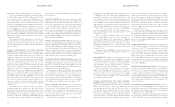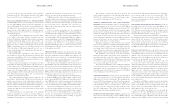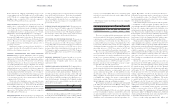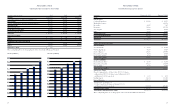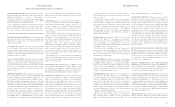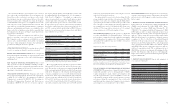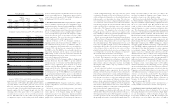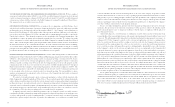Abercrombie & Fitch 2004 Annual Report Download - page 19
Download and view the complete annual report
Please find page 19 of the 2004 Abercrombie & Fitch annual report below. You can navigate through the pages in the report by either clicking on the pages listed below, or by using the keyword search tool below to find specific information within the annual report.
Abercrombie &Fitch
35
Abercrombie &Fitch
the above mentioned grants to the Chairman and the non-associate
directors is generally four years. Compensation expenses related to
restricted share awards amounted to $10.4 million, $5.3 million and
$2.3 million in 2004, 2003 and 2002, respectively.
11. RETIREMENT BENEFITS The Company maintains a qualified
defined contribution retirement plan and a nonqualified supple-
mental retirement plan. Participation in the qualified plan is available
to all associates who have completed 1,000 or more hours of service
with the Company during certain 12-month periods and attained
the age of 21. Participation in the nonqualified plan is subject to
service and compensation requirements. The Company’s contribu-
tions to these plans are based on a percentage of associates’ eligible
annual compensation. The cost of these plans was $9.1 million in
2004, $6.4 million in 2003 and $5.6 million in 2002.
Effective February 2, 2003, the Company established a
Supplemental Executive Retirement Plan (the “SERP”) to pro-
vide additional retirement income to its Chairman. Subject to
service requirements, the Chairman will receive a monthly bene-
fit equal to 50% of his final average compensation (as defined in
the SERP) for life. The SERP has been actuarially valued by an
independent third party and the expense associated with the
SERP is being accrued over the stated term of the Amended and
Restated Employment Agreement, dated as of January 30, 2003,
between the Company and its Chairman.
Effective May 17, 2004, the Company established a Supplemental
Executive Retirement Plan (the “SERP”) to provide additional
retirement income to its President and Chief Operating Officer.
Subject to service requirements, upon retirement at age 57 the
President and Chief Operating Officer would receive a monthly
annuity of $8,333.33 for life. The monthly amount would be actu-
arially increased for retirement after age 57, or reduced 20% per year
for retirement prior to age 57. The SERP has been actuarially valued
by an independent third party and the expense associated with the
SERP is being accrued over the stated term of the Employment
Agreement, dated as of May 17, 2004, between the Company and its
President and Chief Operating Officer.
12. CONTINGENCIES The Company is involved in a number of
legal proceedings that arise out of, and are incidental to, the conduct
of its business.
In 2003, five actions were filed in different state courts under
various states’ laws on behalf of purported classes of employees and
former employees of the Company alleging that the Company
required its associates to wear and pay for a “uniform” in violation
of applicable law. In each case, the plaintiff, on behalf of his or her
purported class, sought injunctive relief and unspecified amounts of
economic and liquidated damages. Two of the actions were ordered
coordinated in November of 2003 and on February 28, 2005, were
settled and dismissed with prejudice as to the individual claims and
without prejudice as to the putative class claims. Two other cases
were stayed in the state court proceedings and the plaintiffs in those
cases joined in the action in federal court described in the immedi-
ately following paragraph. In connection with the settlement of that
federal court action, the two related state court cases were dismissed
with prejudice. The Company has filed an answer in the remaining
state court action. The plaintiffs in that action filed, and the
Company opposed, a motion to certify a class of employees in the
State of Washington. The Court granted the plaintiffs’ motion and
the Company has commenced a discretionary appeal thereof.
In 2003, an action was filed in the United States District Court for
the Western District of Pennsylvania, in which the plaintiff alleged
that the “uniform,” when purchased, drove associates’ wages below
the federal minimum wage. The complaint purported to state a col-
lective action on behalf of part-time associates under the Fair Labor
Standards Act. On November 17, 2004, the Court gave final approval
of the settlement of this case and the two state court cases whose
plaintiffs had joined in the federal court action, and dismissal of the
case with prejudice was entered. The settlement is not material to
the consolidated financial statements of the Company.
As previously mentioned, five of the above-described cases have
been settled. The Company does not believe it is feasible to predict
the outcome of the remaining state court legal proceeding described
above and intends to vigorously defend against it. The timing of the
final resolution of that proceeding is also uncertain. Accordingly,
the Company cannot estimate a range of potential loss, if any, for
that legal proceeding.
In each of 2004, 2003 and 2002, one action was filed against the
Company involving overtime compensation. In each action, the
plaintiffs, on behalf of their respective purported class, seek injunctive
relief and unspecified amounts of economic and liquidated damages.
In the action which was filed in state court under California law in
2002, the parties are in the process of discovery, and the trial court has
ordered a class of store managers in California certified for limited
purposes. In the action which was filed in the United States District
Court for the Southern District of Ohio in 2003, the Company has
filed a motion to dismiss which was denied as to certain of the plain-
tiffs and remains pending as to certain claims of a third plaintiff. The
parties in this action have commenced discovery.
In the remaining case, which was filed on December 28, 2004 in
the United States District Court for the Eastern District of Tennessee,
the Company has filed an answer. The Company does not believe it
is feasible to predict the outcome of the legal proceedings described in
this paragraph and intends to defend vigorously against them. The
timing of the final resolution of each of these proceedings is also
uncertain. Accordingly, the Company cannot estimate a range of
potential loss, if any, for any of these legal proceedings.
In 2003, an action was filed in the United States District Court for
the Northern District of California on behalf of a purported class
alleged to be discriminated against in hiring or employment decisions
due to race and/or national origin. The plaintiffs in this action
sought, on behalf of their purported class, injunctive relief and
unspecified amounts of economic, compensatory and punitive dam-
ages. Two other purported class action employment discrimination
lawsuits were subsequently filed in the United States District Court
for the Northern District of California, both on November 8, 2004.
One alleged gender (female) discrimination in hiring or employment
decisions and sought, on behalf of the purported class, injunctive
relief and unspecified amounts of economic, compensatory and
punitive damages. The other was brought by the Equal Employment
Opportunity Commission (the “EEOC”) alleging race, ethnicity
and gender (female) discrimination in hiring or employment deci-
sions. The EEOC complaint sought injunctive relief and, on behalf
of the purported class, unspecified amounts of economic, compensa-
tory and punitive damages. On November 8, 2004, the Company
signed a consent decree settling these three related class action dis-
crimination lawsuits, subject to judicial review and approval. The
monetary terms of the consent decree provided that the Company
would set aside $40.0 million to pay to the class, approximately $7.5
million for attorneys’ fees, and approximately $2.5 million for mon-
itoring and administrative costs to carry out the settlement. As a result,
the Company accrued a non-recurring charge of $32.9 million,
which was included in general, administrative and store operating
expenses for the third quarter of fiscal 2004. This was in addition to
amounts accrued during the first quarter of fiscal 2004 when the
Company recorded an $8.0 million charge (net of expected proceeds
of $10 million from insurance) resulting from an increase in expect-
ed defense costs related to the case filed in 2003. The preliminary
approval order was signed by Judge Susan Illston of the United
States District Court for the Northern District of California on
November 16, 2004, and that order scheduled a final fairness and
approval hearing for April 14, 2005.
The Company accrues amounts related to legal matters if rea-
sonably estimable and reviews these amounts at least quarterly.
13. PREFERRED STOCK PURCHASE RIGHTS On July 16, 1998,
A&F’s Board of Directors declared a dividend of .50 of a Series A
Participating Cumulative Preferred Stock Purchase Right (Right)
for each outstanding share of Class A Common Stock, par value
$.01 per share (Common Stock), of A&F. The dividend was paid
to shareholders of record on July 28, 1998. Shares of Common
34
Options Outstanding Options Exercisable
at January 29, 2005 at January 29, 2005
Weighted–
Average Weighted– Weighted–
Range of Remaining Average Average
Exercise Number Contractual Exercise Number Exercise
Prices Outstanding Life Price Exercisable Price
$ 8-$23 991,000 3.3 $12.26 613,000 $13.00
$23-$38 6,130,000 5.9 $26.56 3,804,000 $25.86
$38-$51 4,908,000 4.6 $43.85 2,445,000 $43.76
$ 8-$51 12,029,000 5.2 $32.44 6,862,000 $31.09
A summary of option activity for fiscal 2004, 2003 and 2002 follows:
Number of Weighted–Average
2004 Shares Option Price
Outstanding at beginning of year 14,839,900 $30.03
Granted 484,000 36.48
Exercised (2,564,000) 19.49
Canceled (730,000) 31.67
Outstanding at end of year 12,029,900 $32.44
Options exercisable at year-end 6,862,000 $31.09
2003
Outstanding at beginning of year 16,059,000 $28.31
Granted 640,000 27.89
Exercised (1,586,600) 12.39
Canceled (272,500) 27.04
Outstanding at end of year 14,839,900 $30.03
Options exercisable at year-end 6,191,000 $27.04
2002
Outstanding at beginning of year 12,961,000 $28.65
Granted 3,583,000 26.53
Exercised (93,000) 16.44
Canceled (392,000) 26.31
Outstanding at end of year 16,059,000 $28.31
Options exercisable at year-end 4,556,000 $19.10
A total of 507,500, 78,000 and 1,046,000 restricted shares were
granted in fiscal 2004, 2003 and 2002, respectively, with a total market
value at grant date of $16.0 million, $2.1 million and $28.0 million,
respectively. Of the restricted shares granted in 2002, 1,000,000
shares were awarded to the Company’s Chairman, which become
vested on December 31, 2008 provided the Chairman remains con-
tinuously employed by the Company through such date. The
remaining restricted share grants either vest on a graduated scale
over four years for associates or over one year for the non-associate
directors. The market value of restricted shares is being amortized
as compensation expense over the vesting period, which excluding


